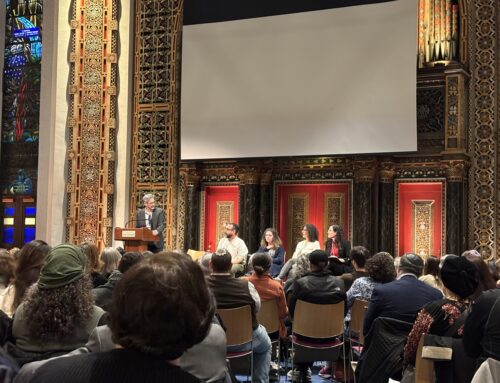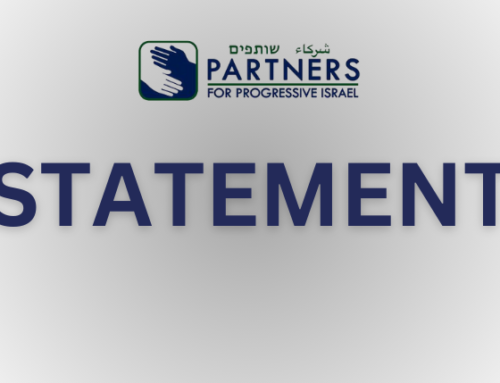Prior to last week I’d never heard of Ras al-Amud. That’s not surprising. As an American Jew, I was not meant to. I was not meant to know that Ras al-Amud even existed, because to know that it exists, that it is a Palestinian neighborhood in East Jerusalem that is located just south of the old city and overlooks Silwan and Abu Dis, and that in 2003 it had a population of 11,922, is to admit that Palestinians have a legitimate claim and right to Jerusalem.
As an American Jew I’m not “supposed” to know that. It’s another part of the Occupation; a way of trying to hide something you don’t want known, a way of trying to make people and neighborhoods invisible and of making identities disappear. Two years ago I had never heard of Silwan, though I had actually been to the neighborhood several times, so to say I know where Ras al-Amud is because I know where Silwan is already means I know way more than the powers that be ever wanted me to.
Last week the Sheikh Jarrah Solidarity Movement held two demonstrations in Ras al-Amud (two years ago I had not heard of Sheikh Jarrah either, in spite of the fact that it was the neighborhood at the foot of the University I’d studied at and neighborhood I’d lived in for a year and a half, and in spite of the fact I’d been through the neighborhood countless times on buses and in taxies). These non-violent demonstrations were in protest of the ground breaking of a new settlement in the heart of Ras al-Amud, called Maaleh David, which had just been approved by the municipality and of the existing settlement Maaleh Zeitim to which it will not only be adjacent but also connected to by a bridge. Maaleh Zeitim is already the largest settlement in any of the Palestinian neighborhoods of East Jerusalem, with more than a hundred housing units. The addition of Maaleh David alongside it serves to highlight the Israeli government policy of moving Jews into areas that are populated by Palestinians to inhibit the ability of that region from being exclusively Palestinian and thus preventing it from being part of a future Palestinian state. It’s the “facts on the ground” method; if we build it the world can’t possibly ask us to give it up in the future.
I’ve been following developments in Ras al-Amud for a week now. The second of the two demonstrations last week turned violent when police used unprecedented force against Israeli demonstrators. It is standard operating procedure for the Israeli police and army to use violence when putting down non-violent Palestinian protests, but the use of batons and tasers by police against Israelis was entirely new.
These events are significant on multiple levels: the strategy of solidarity, the tactic of civil disobedience and the recognition and acceptance of another’s identity, all of which are important for ending the Occupation. While it is disturbing to know that police used violence to put down the peaceful demonstration of its own citizens, what is more significant is the fact that these demonstrations are occurring. The work of the Sheikh Jarrah Solidarity Movement is what its name indicates; based on solidarity, the solidarity of Israelis with Palestinians, of West Jerusalemites with East Jerusalemites, of residents of a city standing together in voicing their opposition to unjust policies and laws. So, first and foremost, the events in Ras al-Amud and Sheikh Jarrah are significant because they are based on solidarity.
Second, the conversations of many involved in the protests are once again focusing on civil disobedience. Many of the members of the Sheikh Jarrah Solidarity Movement have already been arrested, some multiple times, for their non-violent demonstrations. The decisions to break a law, risk bodily harm, and get arrested cannot be taken lightly. Civil disobedience is the breaking of laws. Specifically, it is the breaking of unjust laws because of a recognition that certain laws sometimes work to stymie justice and that there is a moral justification to break those laws in order to pursue justice. Technically, a sit-in that blocks the entrance to a settlement is illegal. So last week when Israelis and Palestinians sat down together in the road to block the entrance of a settlement, a settlement that was built to purposely fracture the Palestinian community of Ras al-Amud, a settlement that violates Article 49 of the Fourth Geneva Convention to which Israel is a party, they were breaking the law. Six protestors were arrested.
Solidarity and civil disobedience are extremely important. They are two of the tools of justice. And the weekly Friday protests in Sheikh Jarrah and now perhapsRas al-Amud are steeped in both.
But Solidarity and civil disobedience in the face of injustice are not the only reasons why these protests are important, they are also important because they reaffirm the names of people’s communities and by extension their identities. In 1998 when I was 18 I did not know that Sheikh Jarrah existed because I was told not to ride the bus line that went thorough that “dangerous, dirty village where terrorists live”. In 2000 when I was 21 I did not know that Sheikh Jarrahexisted because when I asked what that area was and who lived there I was told “don’t worry about it, it’s just some unimportant Arab village”. But in the summer 2009 when I was 30 I slept in the houses of Mahar Hanoun and Nasser al-Ghawi and their families. I slept in their homes because even though they had legitimate legal deeds to their homes they were going to be evicted. I slept in their homes because Israeli police carry out evictions in the middle of the night and the hope was that if internationals were in the houses it would deter the families’ evictions. They welcomed me, an American Jewish woman, to stand in solidarity with them against the court-ordered and yet unjust prospect of being made homeless because they are not Jews. I slept in their homes, and learned that their homes were in a neighborhood called Sheikh Jarrah, and in the middle of the night of August 1, 2009 (early in the morning of August 2, 2009), on a night when I was in my bed in my apartment in the neighborhood of French Hill, the Hanoun and al-Ghawi families were evicted from their homes. I spent the rest of the month standing in solidarity with the families as they protested outside of their own homes, homes that Israeli settlers now occupied.
For 11 years the name Sheikh Jarrah had been hidden from me, divorced from the place it represented, and in a very Orwellian way disappeared from people’s consciousness. But not all people’s consciousness, just some; the Hanouns and the al-Ghawis and the other residents of Sheikh Jarrah knew what their neighborhood was called; the name had been erased for me and other Jews so that we would not know. Just like until last week the name Ras al-Amud had been erased for me and others.
It is important to talk about Ras al-Amud because solidarity is a powerful strategy for just change. It is important to talk about Ras al-Amud because civil disobedience is a powerful tactic for just change. And it is important to talk about Ras al-Amud because though some would like to keep the name Ras al-Amudhidden and rename the area other things like Maaleh Zeitim and Maaleh David, they cannot change the fact that Ras al-Amud exists. Last week the news broke, and in solidarity, and with the use of civil disobedience, the protesters were heard, and a name entered the consciousness of a larger audience.
Sarah Strnad
Assistant Director
June 10, 2011






Leave A Comment